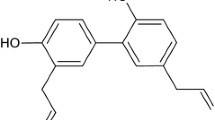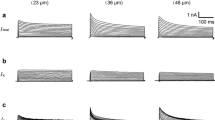Abstract
The effects of rises in external K+ (Kext) were examined on the hyperpolarization-activated cation current (I h) in rat dorsal root ganglion neurons using the whole-cell patch clamp technique. The results showed that Kext increased I h in a certain concentration and voltage-dependent manner. At the basal Kext level (4 mmol/L), I h had a maximal amplitude of 1085 ± 340 pA which was enhanced by ∼45% and ∼92% at 8 and 16 mmol/L Kext, respectively. The midpoint activation voltage was significantly shifted from −98 mV in the hyperpolarizing direction by 8 and 12 mV at 8 and 16 mmol/L Kext, respectively with alteration of the activation course of I h. The short time constants of activation became longer with the increasing amplitude of the command potential upon rises in Kext. The long time constants became shorter. The reversal potentials were shifted in the positive direction without significant alterations upon rises in Kext. According to the functional role of I h, Kext increased I h, resulting in an enhanced neuronal excitability, which might produce activation potential abnormality and perhaps neuropathic pain involved.
Similar content being viewed by others
References
Liu C N, Michaelis M, Amir R, Devor M. Spinal nerve injury enhances sub-threshold membrane potential oscillations in DRG neurons: Relation to neuropathic pain. J Neurophysiol, 2000,84:205–215
Luo F. Pathology ache and dorsal root ganglion (in Chinese). Shanghai J Acupunct Moxibusti, 2005, 242: 36–36
Banks M Y, Pearce R A, Smith P. Hyperpolarization-activated cation current (I h) in neurons of the medial nucleus of the trapezoid body; voltage-clamp analysis and enhancement by norepinephrine and cAMP suggest a modulatory mechanism in the auditory brain stem. J Neurophysiol, 1993, 70: 1420–1430
DiFrancesco D. Block and activation of the pace-maker channel in calf purkinje fibres: Effects of potassium, caesium and rubidium. J Physiol, 1982, 329: 485–507
Wang Z, Van B D, Ypey D L. Hyperpolarization-activated currents in the growth cone and soma of neonatal rat dorsal root ganglion neurons in culture. J Neurophysiol, 1997, 78: 177–186
McCormick D A, Pape H C. Properties of a hyperpolarization-activated cation current and its role in rhythmic oscillation in thalamic relay neurons. J Physiol, 1990, 431:291–318
Pape H C. Queer current and pacemaker: The hyperpolarization-activated cation current in neurons. Annu Rev Physiol, 1996, 58: 299–327
Scroggs R S, Todorovic S M, Andeson E G, Fox A P. Variation in I H, I IR, I LEAK between acutely isolated adualt rat dorsal root ganglion neurons of different size. Neurophysiol, 1994, 1: 71–279
Surges R, Freiman T M, Feuerstein T J. K+-induced changes in the properties of the hyperpolarization-activated cation current I h rat CA1 pyramidal cells. Neurosci Lett, 2002, 332: 136–140
Deng L B, Cao X J, Yao L, Han J S, Wan Y. Alteration of hyperpolarization-activated current (I h) in dorsal root ganglion neurons in rats with neuropathic pain induced by spinal nerve ligation (in Chinese). J Peking Univ, 2002, 34: 252–255
Gabriel S, Eilers A, Kivil A, Kovacs R, Schulze K, Lehmann T N, Heinemann U. Effects of barium on stimulus induced changes in extracellular potassium concentration in area CA1 of hippocampal slices from normal and pilocarpine-treated epileptic rats. Neurosci Lett, 1998, 242: 9–12
Chaplan S R, Guo H Q, Lee D H, Luo L, Liu C, Kuei C, Velumian A A, Butler M P, Brown S M, Dubin A E, Neuronal hyperpolarization-activated pacemaker channels drive neuropathic pain. J Neurosci, 2003,23(4): 1169–1178
Dalle C, Eisenach J C, Peripheral block of the hyperpolarization-activated cation current (I h) reduces mechanical allodynia in animal models of postoperative and neuropathic pain. Reg Anesth Pain Med, 2005, 30(3): 243–248
Sun Q, Xing G G, Tu H Y, Han J S, Wan Y. Inhibition of hyperpolarization-activated current by ZD7288 suppresses ectopic discharges of injured dorsal root ganglion neurons in a rat model of neuropathic pain. Brain Res, 2005, 1032(1–2): 63–69
Jauch R, Windmüller O, Lehmann T N, Heinemann U, Gabriel S, Effects of barium, furosemide, ouabaine and 4,4′-diisothiocyanatostilbene-2,2′-disulfonic acid (DIDS) on ionophoretically-induced changes in extracellular potassium concentration in hippocampal slices from rats and from patients with epilepsy. Brain Res, 2002, 925: 18–27
Wahl-Schott C, Biel M. HCN channels: Structure, cellular regulation and physiological function. Cell Mol Life Sci, 2009, 66(3): 470–494
Du Z Q, Zhou Y F, Yang P. Sulfur dioxide derivatives increase a hyperpolarization-activated inward current in dorsal root ganglion neurons. Toxicology, 2007, 239: 180–185
Harris N C, Constanti A. Mechanism of block by ZD7288 of the hyperpolarization-activated inward rectifying current in guinea pig substantia nigra neurons in vitro. J Neurophysiol, 1999, 74: 2366–2378
Satoh T, Yamada M. A bradycardia agent ZD7288 blocks the hyperpolarization-activated current (I h) in retinal rod photoreceptors. Neuropharmacology, 2000,39:1284–1291
Ingram S L, Wartenson T J. Opioid inhibition of I h via adenylyl cyclase. Neuron, 1994,13:179–186
Luo L, Chang L, Brown S M, Ao H, Lee D H, Higuera E S, Dubin A E, Chaplan S R. Role of peripheral hyperpolarization-activated cyclic nucleotide-modulated channel pacemaker channels in acute and chronic pain models in the rat. Neuroscience, 2007,144(4):1477–1485
Marbán E, Cho H C. Biological pacemakers as a therapy for cardiac arrhythmias. Curr Opin Cardiol, 2008, 23(1): 46–54
Lyashchenko A K, Tibbs G R. Ion binding in the open HCN pacemaker channel pore: Fast mechanisms to shape “slow” channels. J Gen Physiol, 2008, 131(3): 227–243
Kilb W, Dierkes P W, Syková E, Vargová L, Luhmann H J, Hypoosmolar conditions reduce extracellular volume fraction and enhance epileptiform activity in the CA3 region of the immature rat hippocampus. J Neurosci Res, 2006, 84(1): 119–129
Nie A F, Meng Z Q. Sulfur dioxide derivative modulation of potassium channels in rat ventricular myocytes. Arch Biochem Biophys, 2005, 442:187–195
Somjen G G. Ion regulation in the brain: Implications for pathophysiology. Neuroscientist, 2002, 8(3): 254–267
Benninger C, Kadis J, Prince D A, Extracellular calcium and potassium changes in hippocampal slices. Brain Res, 1980, 187: 165–182
Author information
Authors and Affiliations
Corresponding author
Additional information
Supported by the University of Science and Technology Foundation of Shanxi Province (Grant No. 200713010)
Rights and permissions
About this article
Cite this article
Du, Z., Wu, W. & Zhou, Y. The effects of rises in external K+ on the hyperpolarization-activated cation current I h in rat dorsal root ganglion neurons. Sci. China Ser. B-Chem. 52, 1258–1263 (2009). https://doi.org/10.1007/s11426-009-0140-x
Received:
Accepted:
Published:
Issue Date:
DOI: https://doi.org/10.1007/s11426-009-0140-x




